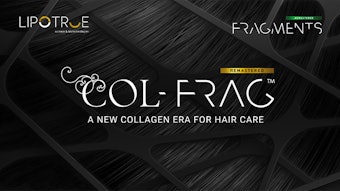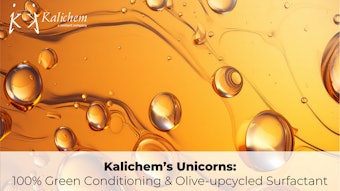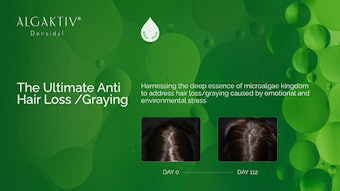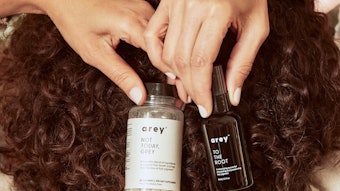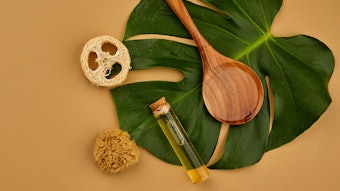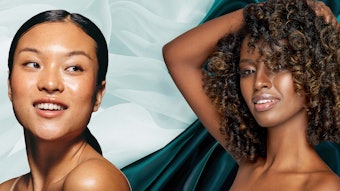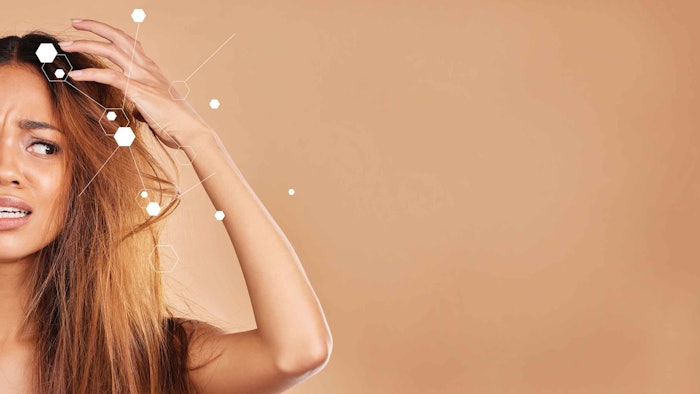
Hair is a highly organized and complex visco-elastic biopolymer composite of primarily keratin. It is anchored by the follicle that undergoes a process of regeneration, controlling the production and growth rate of the hair fiber. The hair structure is composed of a cuticle, cortex and medulla, although the medulla is not always present, especially in fine thin hair.
Log in to view the full article
Hair is a highly organized and complex visco-elastic biopolymer composite of primarily keratin. It is anchored by the follicle that undergoes a process of regeneration, controlling the production and growth rate of the hair fiber. The hair structure is composed of a cuticle, cortex and medulla, although the medulla is not always present, especially in fine thin hair.
The hair’s strength and resilience is due to its complex protein structures enforced by covalent, ionic and hydrogen bonds as well as hydrophobic interactions within the cortex and cuticle. Within the cortex, the crystalline α-helical core of keratin is extensively cross-linked through disulfide bond formation with the amorphous keratin-associated proteins (KAPs). This complex protein structure is enveloped in a protective cuticle sheath rich in cysteine, with a laminar structure supported by a cell membrane complex and sealed with a hydrophobic barrier, known as the f-layer, of primarily covalently bound 18-methyl eicosanoic acid (18-MEA).1
The cuticle protects the hair from chemical, mechanical and environmental insult. Across all hair types, the chemical analysis of hair is comparable; however, morphological variation lies within hair pigmentation, ellipticity, hair diameter, rate of growth, cuticle laminar structure and lipid distribution. In almost all societies today, and throughout history, hair has been an object of intense elaboration and adornment. It is also a reflection of an individual’s overall health, and its treatment via chemical process, style and societal rituals visually reflects and communicates a person's lifestyles, beliefs and commitments.
Through advances in science and technology, the professional stylist and consumers alike can change hair through mechanical, heat and chemical treatments, allowing for style, texture and color versatility. These treatments and processes manifest in protein denaturation, cysteine disulfide bond cleavage, lipid removal increasing fiber porosity, cuticle lifting and removal, tensile property changes, cortical and cuticle fractures leading to hair breakage and increased fiber friction.
Compounding the damage from mechanical, thermal and chemical alterations of hair, environmental exposure from UV, humidity and pollution further degrades the weakened fiber. Environmental pollution insults result in protein degradation, surface cracking and hydrophilicity. Dust, in particular, adheres to hydrophilic surfaces such as damaged hair.2
Once hair fiber is damaged it is unable to restore itself to a pre-damaged state. The consumer observes split ends, hair breakage, hair color shifts in intensity and hue, a lack of shine, an increased propensity to frizz, increased combing friction, super-contraction from certain straightening technologies, reduced hair movement and poor hair manageability. Such changes are perceived haptically with cuticle surface changes, specifically with a decrease in smoothness and an increase in dry/brittle hair feel. These surface changes can even be perceived acoustically and instrumentally quantified, when the consumer runs their fingers through or brushes their hair, with an increase in crackling sound.3, 4
The present article explores approaches to remediate various types of hair damage through repair technologies and formulation architectures. Examples include hair bonding technologies, sulfate-free shampoos, reparative conditioners and leave-in treatments; also described are in vitro tests to demonstrate efficacy.
Hair Repair Technologies
In developing a regimen to address fragile hair, one needs a formulation strategy to both address the damage to the fiber from the cortex level to the fiber surface, and to protect the fiber from future insult. Here, a holistic approach is proposed of hair-penetrating actives working from the inside out, and surface-binding technologies operating from the outside in. Together, they fortify hair, reduce crack propagation within the fiber and increase surface hydrophobicity. This is not a new formulation strategy; however, technologies and methodologies have advanced to yield improved on-hair performance, as measured instrumentally and confirmed with consumer/stylist perception.
Over the past several years, pioneered by the invention of bis-aminodiglycol dimaleate,5 bonding actives designed to reform broken bonds through covalent, hydrogen and ionic interactions have emerged in hair products. Covalent technologies work through a thiol-Michaels reaction and/or cross-linking. Several technologies also interact through hydrogen and ionic bonding, hydrophobic and van der Waals interactions addressing damage within the cortex and the cuticle. In essence, they reform bonds or create new bonds and interactions, acting as a scaffold to fortify the protein structure.
Hair-penetrating actives can include amino acids, dicarboxylic acids, alpha hydroxy acids, ceramides and low molecular weight peptides. The typically low molecular weight of these actives helps to achieve an optimum diffusion rate into the damaged fiber from aqueous hair care products. In fact, research by Silva, et al.,6 has concluded that the structure and localization of charge is key to optimizing penetration into damaged hair.
In terms of amino acid technologies, arginine has a strong affinity for hair and may be used as an anchor to bind weaker hair affinity amino acids.7 Several of these technologies also contain film formers, working from the outside-in to address cuticle surface damage. Examples of published hair-bonding actives are provided in Table 1.
 Table 1. Examples of Published Hair-bonding Actives
Table 1. Examples of Published Hair-bonding Actives
Composites of cationic polymers, proteins, silicones, esters, saturated hydrocarbon such as squalane, triglycerides and natural oils contribute to cuticle restoration. Essentially, they behave as a biomimetic f-layer by restoring lost lipids and surface hydrophobicity. There are specific ingredient innovations in this area focusing on natural quaternized 18-MEA or aliphatic cationic compounds of plant peptides designed to mimic 18-MEA. In addition to having a reparative effect on hair, many of these surface technologies provide a shield against oxidative hair color loss, thermal and mechanical styling insults and environmental exposure.
Both inside-out and outside-in technologies can be incorporated across the hair regimen with a minimal routine of a shampoo, in-shower conditioner and leave-in treatment to provide a measurable and perceivable repair benefit to hair.
Sulfate-free Shampoo for Damaged Hair
The primary function of shampoo is to clean the hair and scalp, removing excess sebum, skin cell debris, dirt, environmental pollutants and hair product residue to support a healthy scalp microbiome, hair follicle vitality and clean hair fiber assembly. When formulating a shampoo for damaged hair, key care attributes must be built into the surfactant system while maintaining cleaning efficacy.
These attributes include: surfactant mildness; a rheology profile to enhance spreading; lubricity to prevent hair tangling and breakage; an easy-to-build foam profile with a lubricious, rich density; and manageable foam degradation for ease of rinsing. In delivering repair/conditioning benefits, coacervate deposition technologies comprising small molecules that can diffuse into hair with a short contact time, and mono-layer deposition polymer technologies to complement the coacervate deposition are needed.
Sulfate-free shampoo surfactants are designed to be gentle to the hair and scalp. Similar to sulfate-containing shampoos, sulfate-free formulas will comprise anionic surfactants as the primary cleansing agents, supported by nonionic and/or amphoteric surfactants and may contain polymers to support foam boosting, broadening the salt curve and thickening.
Optimizing surfactant systems to improve performance with reduced surfactant levels may be accomplished through the addition of nonionic cellulose polymers such as hydroxypropyl methylcellulose. Due to association with surfactants and adsorption at the air-water interface, this polymer family boosts foam and decreases bubble size to create foam richness; it also stabilizes the bubble lamellar structure. Surfactant-polymer foam analysis can be assessed using a dynamic foam analyzer.
To prevent tangling during the shampooing process, cationic derivatives of natural polymers such as guar, hydroxyethyl cellulose, dextran, cassia, inulin, starch, etc., can be incorporated for the dual purpose of providing slip and delivering silicones and oils. These polymers have a range of molecular weights and charge densities. Deposition on the hair occurs through the formation of coacervates upon dilution. The size and quantity of the coacervates can be tailored through the cationic polymer’s molecular weight and charge density.
Evaluating interactions with sulfate-free surfactant systems is necessary to optimize their deposition. One strategy to optimize the surfactant level is through the incorporation of hydroxypropyl methylcellulose, which will maximize coacervation formation and enhance the delivery of care ingredients.8 Additionally, these polymers may boost viscosity due to micelle formation along the polymer chain.9
Complementing the deposition technology, a formulator may include cationic polymers that deposit as a mono-layer onto the surface to provide uniformity. These polymers, in combination with coacervate technologies, will support wet combing, wet-conditioned feel, dry hair conditioning benefits and manageability. Surface deposition, in addition to chosen bonding agents in an optimized surfactant system, can increase tensile strength, provide surface lubricity to reduce hair breakage and protect oxidative hair color from wash fastness. Formula 1 provides a sulfate-free formulation framework for damaged hair.
 Formula 1. Sulfate-free Formulation Framework for Damaged Hair
Formula 1. Sulfate-free Formulation Framework for Damaged Hair
Post-shampoo Conditioning for Damaged Hair
Although many technologies have been developed to provide conditioning in a shampoo format, most consumers with damaged hair require a post-shampoo conditioner. Damaged hair, especially bleached and chemically processed hair, has a higher affinity to cationic hair conditioners due to a higher concentration of negative charge and increased porosity. The role of the conditioner is to neutralize the charge caused by shampooing, provide lubricity, restore the hair’s hydrophobicity, increase smoothness, enhance hair alignment and manageability and impart shine.
The foundation of a hair conditioner is the lamellar gel network formed by cationic surfactants swelling the fatty alcohol phase in an o/w emulsion. These layered structures provide slip, allow the dispersion of oils, increase deposition on hair and enhance formulation stability. Behentrimonium (chloride or methyl sulfate counterion) is an excellent choice as the primary cationic surfactant due to its long hydrocarbon chain (C22) to impart hair conditioning properties and cationic polar head to neutralize charge through ionic interactions. Secondary smaller hydrocarbon chain cationic surfactants or tertiary amines such as stearamidopropyl dimethylamine support a balanced distribution of conditioning across the fiber and the lamellar gel network structure. The overall conditioning performance of the lamellar gel network can be optimized through the evaluation of the lamellar microstructure and its breakdown on dilution.10
Leveraging the lamellar gel network deposition profile and adding cationic conditioning polymers, taking care not to disrupt the structure, offers more opportunity for hair surface restoration than the shampoo format. Deposition interactions through ionic, hydrophobic and van der Waals are adaptive depending on the hair’s damage level. Hair surface restoration, such as reducing the hydrophilicity of the damaged cuticle and reducing surface friction through the flattening of the cuticle, thereby increases smoothness and tensile properties.
Hair shine can be enhanced through the deposition of high refractive index polymers such as silicones or by enhancing the hair’s intrinsic shine through cuticle sealing and fiber alignment. Furthermore, the aforementioned bonding technologies, such as amino acids, humectants, ceramides/ceramide analogs and some natural oils – especially coconut oil11 – will penetrate hair at various rates and via different mechanisms to reform bonds, fortify the keratin structure, reinforce the CMC, bind moisture and prevent protein loss.
The texture of the conditioning formula has both a functional and aesthetic appeal. The aesthetics may connote richness, luxuriousness, non-greasiness and a “care” aspect to the formulation. Functionally, the formula’s shear-thinning profile is important to dispensing the product from the container, applying and distributing it through the hair and adhering to hair during in-shower application, to prevent the product from sliding off hair to the shower floor. Advanced rheological techniques can capture the rest and dynamic stress phases of product application to create a signature conditioner texture with optimized functionality.12
The formulation texture may be further developed with nonionic cellulosic polymers, cationic thickeners such as polyquaternium-37, fatty alcohol blends, esters and waxes, emulsifiers, silicones/silicone alternatives and natural butters to help structure, control viscosity and enhance the rheology profile for both package and application while yielding a luxurious texture. Formula 2 provides an example conditioner framework for damaged hair.
 Formula 2. Conditioner Framework for Damaged Hair
Formula 2. Conditioner Framework for Damaged Hair
Leave-in Treatment
A leave-in treatment offers the most benefit to damaged hair given its longer contact time and daily use application. The inside-out technologies employed in the hair conditioner also apply to the leave-in treatment with the opportunity to enhance performance. Bonding technologies can be combined with actives that easily penetrate the cortex and support surface and cuticle bonding for an optimized benefit.
Leave-in treatment formats may include serums, light lotions, creams, milks or bi-phases with applications on both wet and dry hair. They can be structured to be light for fine, thin hair, or emollient rich for thick, textured hair. On wet hair, they provide lubricity to prevent tangling and breakage. Dry hair repair benefits can be delivered through film formation architectures with balanced composites of silicones/silicone alternatives, proteins, oils/esters and conditioning and thickening polymers. These deliver effects including reduced frizz formation, smoothed hair ends, reduced porosity and the pseudo-repair of split ends.
Since leave-in treatments have much lower levels of quaternary surfactants and fatty alcohols than rinse-out conditioners, their rheology may be enhanced with nonionic and cationic polymers to support ease of distribution and slip for application in wet and dry hair. From a leave-in treatment, temporary repair of split ends may be achieved with polymer technologies such as silicones, charged guar polymers, proteins, PECs (polyelectrolyte complexes) and blends thereof designed to infiltrate and mend the split end upon drying.
In addition to reparative technologies, protective technologies should be employed to prevent future damage. Such technologies include thermal protection for up to 450°F, humidity resistance, hair color protection, UV and pollution protection. Hair treated with a leave-in formulation should be evaluated using a flat iron to ensure that it doesn’t smoke; certain ingredients, especially low smoke point natural oils, should be taken into consideration during the formulation process. Thermal protection technologies will act as a sacrificial layer, dissipating heat from the fiber resulting in reduced hair breakage during styling. Additionally, these technologies improve moisture restoration and retention.13
Restoring the hydrophobicity on the cuticle surface protects the fiber assembly from frizz formation during heat styling and humidity exposure. Pollution protection technologies prevent dust adherence and pollution particle penetration, protecting the hair surface proteins and cuticle structure.
Technology and Formulation Assessment
To optimize formulation parameters and deliver transformative benefits to damaged hair, various assessments can be made, e.g., in vitro instrumental analysis, trained panel assessment, stylist evaluation and consumer home use tests. Table 2 highlights such measurement techniques. Final formulation assessments can be conducted on each individual formulation in the regimen or as the full regimen with single and multiple applications.
 Table 2. Hair and Hair Treatment Measurement Techniques
Table 2. Hair and Hair Treatment Measurement Techniques
Summary
Hair is stressed to various degrees from chemical, mechanical, heat and environmental insults. A holistic approach to damage using inside-out and outside-in technologies has been shown to provide hair repair benefits. This encompasses small molecules to penetrate into the cuticle/cortex to reform and create new interactions that stabilize the protein structure; and larger molecules or polymer/hydrophobic composites that restore hydrophobicity at the cuticle surface to replace the lost f-layer. Such a combined approach strengthens the fiber and increases lubricity at the surface, reducing breakage, split ends and frizz formation. To further prevent damage, technologies can be incorporated to protect hair against thermal, mechanical and environmental damage.
To protect fragile hair during the washing process, a damaged hair regimen should start with care at the shampoo level and include, minimally, a conditioner and leave-in treatment. Additional formats to consider include pre-shampoo conditioners to lubricate the fiber before shampooing; co-wash formulations to support in-between shampoos; deep conditioning hair masks; and overnight treatments.
Continued collaborations across formulation techniques, ingredient technologies and measurement science, such as those described here, in addition to consumer insights will provide a deeper mechanistic understanding of ingredient and formulation interactions with damaged hair. This, in turn, will provide next-generation solutions.
References
1. Shimomura, Y. and Ito, M., (2005, Dec). Human hair keratin-associated proteins. Journal of Investigative Dermatology Symposium Proceedings. 10(3) 230-233.
2. Qu, X., Niu, B. and Foltis, L. (2018, Apr). Underlining best methods to evaluate efficacy of hair care ingredients - Aiming at environmental pollution protection. Hair Care & Restoration Conference. London, UK.
3. Nomura, M., Ide, H., Kamigori, A., Velleman, D., Flament, F., Isshiki, K., Tanaka, F. and Uragami, S. (2017). Translating the human hair surface state into sound. IFSCC Magazine. 20(1) 3-7.
4. McMullen, R., Schiess, T., Kulcsar, L., Foltis, L. and Gillece, T. (2020). Evaluation of the surface properties of hair with acoustic emission analysis. Intl J Cosm Sci. 1-14.
5. Pressly, E.D. and Hawker, C.J. (2015, Aug 4). Methods for fixing hair and skin. U.S. Patent US 9,095.518 B2. U.S. Patent Office. Available at https://pubchem.ncbi.nlm.nih.gov/patent/US-9095518-B2
6. Silva, C.J., Vasconcelos, A. and Cavaco-Paulo, A.(2007, Jul/Aug). Peptide structure: Its effect on presentation of human hair. J Cosm Sci. 58 339-346.
7. Oshimura, E., Abe, H. and Oota, R. (2007, Jul/Aug). Hair and amino acids: The interactions and the effect. J Cosm Sci. 58 347-357.
8. Jordan, S., DiAntonio, E., Drovetskaya, T., Amos, J., Davis, C., Ladika, M., Kalantar, T., Zhang, X., Gaynor, S. and Kreeger, L. (2008, Aug). Synergistic effects of non-ionic polymers on cationic polymer/surfactant interactions. Conference 236th ACS National Meeting. Philadelphia, PA.
9. Cornwell, P.A. (2018, Feb).A review of shampoo surfactant technology: Consumer benefits, raw materials and recent developments. Intl J Cosm Sci. 40(1) 16-30.
10. Davies, A.R. and Amin, S. (2020, Jun). Microstructure design of CTAC:FA and BTAC:FA lamellar gels for optimized rheological performance utilizing automated formulation platform. Intl J Cosm Sci. 42(3) 259-269.
11. Rele, A.S. and Mohile, R.B. (2003, Mar/Apr). Effect of mineral oil, sunflower oil and coconut oil on prevention of hair damage. J Cosm Sci. 54(2) 175-92.
12. Gillece, T., McMullen, R.L., Fares, H., Senak, S., Ozkan, S. and Foltis, L. (2016, May/Jun). Probing the textures of composite skin care formulations using large amplitude oscillatory shear. J Cosm Sci. 67 121-159.
13. Zhou, Y., Rigoletto, R., Koelmel, D., Zhang, G., Gillece, T.W., Foltis, L. Moore, D.J. , Qu, X. and Sun, C. (2011, Mar/Apr). The effects of various cosmetic pretreatments on protecting hair from thermal damage of hot flat iron. J Cosm Sci. 62 265-282.
14. Wortmann, F.J., Springob, C. and Sendelbach, G. (2002). Investigations of cosmetically treated human hair by DSC in water. J Cosm Sci. 53 219-228.
15. Evans, T. and Wickett, R.R. (2012). Practical modern hair science. Allured Business Media. Carol Stream, IL USA. pp 223 – 233.
16. Evans, T.A. (2009, Nov/Dec). Fatigue testing of hair – A statistical approach to hair breakage J Cos Sci. 60 599-616.
17. Zhou, Y., Foltis, L., Moore, D.J. and Rigoletto, R. (2009, Mar/Apr). Protection of oxidative hair color fading from shampoo washing by hydrophobically modified cationic polymers. J Cosm Sci. 60 217-238.
18. Rigoletto, R., Zhou, Y. and Foltis, L. (2007, Jul/Aug). Semi-permanent split end mending with a polyelectrolyte complex. J Cosm Sci. 58 451-476.
19. McMullen, R. and Jachowicz, J. (2004, Jan/Feb). Optical properties of hair – Detailed examination of specular reflection patterns in various hair types. J Cosm Sci. 55 29-47.
20. Qu, X., Niu, B., Kroon, B. and Foltis, L. (2018, Feb). Pollution damage and protection of Asian hair. Cosmetics. 5(1) 17.
